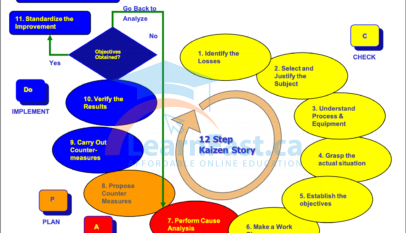Introduction
This training module is designed for use by Safety Department when training and retraining staff about fire safety and fire extinguisher use. It is important to remember that all fires are dangerous and can grow in size rapidly, and become out of control.
Characteristics of Fire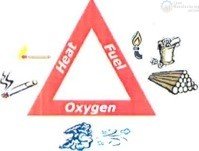
Fire is a living, breathing process that is commonly referred to as the process of combustion. Combustion is the self-sustaining process of rapid oxidation of a fuel, which produces light and heat.
Fire is the result of this rapid combustion reaction. Fire needs 3 items to survive and sustain combustion: fuel, heat and oxygen. These three things combined create the chemical chain reaction that causes combustion; the result is fire. Remove any one of these three items and the chain of combustion is broken and the fire is extinguished.
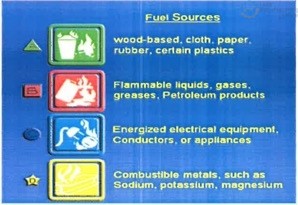
Removal of Fuel ex: Turning the source off (natural gas) from a BBQ fire will cease the fire.
Removal of Heat ex: Turning the element off on a stove with a pot of grease on it will decrease the extent of the fire and if given time will extinguish itself.
Removal of Oxygen ex: Putting a lid on the same pot of grease will smother the fire and remove the oxygen, thus extinguishing the fire.
How Fire Extinguishers Work?
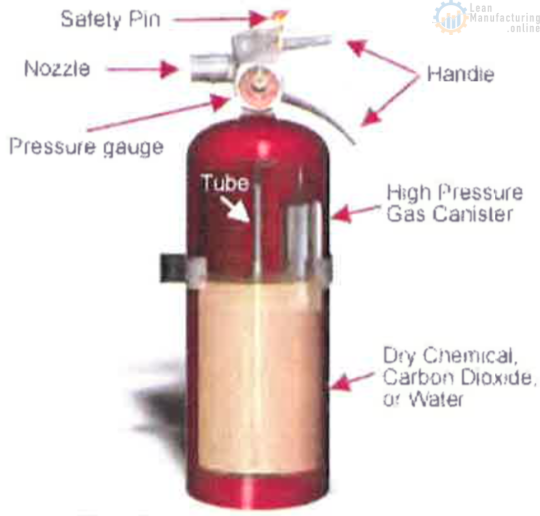 Portable fire extinguishers apply an extinguishing agent that will cool the burning fuel, displace or remove oxygen, or stop the chemical reaction so a fire cannot continue to burn.
Portable fire extinguishers apply an extinguishing agent that will cool the burning fuel, displace or remove oxygen, or stop the chemical reaction so a fire cannot continue to burn.
When the handle of an extinguisher is compressed, it opens an inner canister of high-pressure gas that forces the extinguishing agent from the main cylinder through a siphon tube and out the nozzle.
Important Facts about Fire Extinguishers and their use:
- The extinguisher must be right for the type of fire.
- It must be located where it can be easily reached.
- It must be in good working order.
- The fire must be discovered while it is still small.
- The person using the extinguisher must be trained to use it properly
Types of Fire Extinguishers
Water is one of the most commonly used extinguishing agents for type A fires. You can recognize an APW by its large silver  container. They are filled about two-thirds of the way with ordinary water, then pressurized with air. In some cases, detergents are added to the water to produce a foam. They stand about two to three feet tall and weigh approximately 25 pounds when full.
container. They are filled about two-thirds of the way with ordinary water, then pressurized with air. In some cases, detergents are added to the water to produce a foam. They stand about two to three feet tall and weigh approximately 25 pounds when full.
APWs extinguish fire by cooling the surface of the fuel to remove the “heat” element of the fire triangle.
Never use water to extinguish flammable liquid fires. Water is extremely ineffective at extinguishing this type of fire and may make matters worse by the spreading the fire.
Never use water to extinguish an electrical fire. Water is a good conductor and may lead to electrocution if used to extinguish an electrical fire. Electrical equipment must be unplugged and/or de-energized before using a water extinguisher on an electrical fire.
APWs are designed for Class A (wood, paper, cloth, rubber, and certain plastics) fires only. They will most likely have a label on the fire extinguishers similar to the one below:
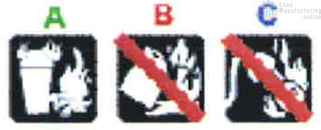
Carbon dioxide extinguisher
This type of extinguisher is filled with Carbon Dioxide (CO2), a non-flammable gas under extreme pressure.
These extinguishers put out fires by displacing oxygen, or taking away the oxygen element of the fire triangle. Because of its high pressure, when you use this extinguisher pieces of dry ice shoot from the horn, which also has a cooling effect on the fire. You can recognize this type of extinguisher by its hard horn and absent pressure gauge.
CO2 cylinders are red and range in size from five to 100 pounds or larger.
CO2 is not recommended for Class A fires because they may continue to smolder and re-ignite after the CO2 dissipates.
Never use CO2 extinguishers in a confined space while people are present without proper respiratory protection.
CO2 extinguishers are designed for Class B and C (flammable liquid and electrical) fires only. They will most likely have a label on the fire extinguishers similar to the one below:
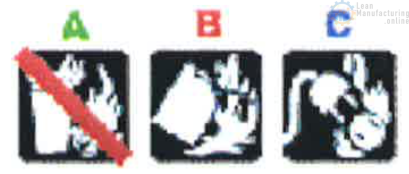
Dry chemical extinguishers
These types of extinguishers put out fires by coating the fuel with a thin layer of fire-retardant powder, separating the fuel from 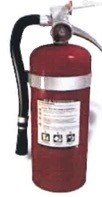 the oxygen. The powder also works to interrupt the chemical reaction, which makes these extinguishers extremely effective.
the oxygen. The powder also works to interrupt the chemical reaction, which makes these extinguishers extremely effective.
Dry chemical extinguishers are usually rated for class B and C fires and may be marked multiple purpose for use in A, B, and C fires. They contain an extinguishing agent and use a compressed, nonflammable gas as a propellant.
Dry Chemical extinguishers will have a label indicating they may be used on class A, B, and/or C fires.
They will most likely have a label on the fire extinguishers similar to the ones below:

Extinguisher Use
* Incipient stage fire. The fire is limited to the original material ignited; it is contained (such as in a waste basket) and has not spread to other materials. The flames are no higher than the firefighter’s head.
As soon as a fire is discovered:
- Sound the fire alarm and call
- Select a safe evacuation path before approaching the fire, do not allow the heat, smoke, or fire come between you and the evacuation path.
- Discharge the fire extinguisher with its appropriate range using the P.A.S.S techniques (pull, aim, squeeze, sweep).
- Back away from an extinguished fire in case it flames up.
- Evacuate immediately if the fire extinguisher is empty and the fire is not yet out.
- Evacuate immediately if the fire progresses passed the incipient stage. While in the process of evacuating double checking letting others aware of the fire taking place.
Tips for safe extinguisher use:
- Test that the extinguisher works before you approach the fire.
- Protect yourself at all times.
- Take care. Speed is essential but it is more important to be cautious.
Keep your back to the exit at all times and stand 2 to 2.4m (6 to 8 ft.) away from the fire. Follow the 4-step P.A.S.S. procedure:
Pull, Aim, Squeeze, Sweep
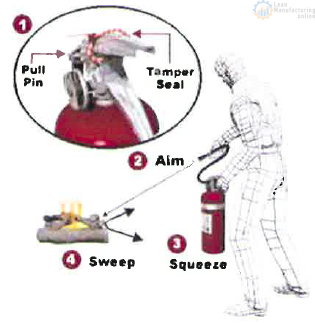
After a Fire
Ensure that your supervisor has been called.
They will make sure that you receive another extinguisher to replace the one that was used. Your supervisor will also determine if the area is safe to resume work and will try to determine the cause of the fire.
Root Cause Analysis can be used to prevent similar accidents from happening in the future.
This training is only for reference – always follow safety rules prescribed by your local legislation or H&S department.



